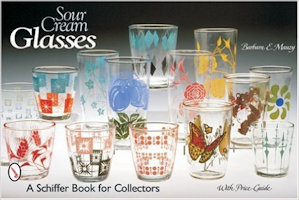
 Advertising Glass
Advertising Glass
paperweight for real
estate in Glassport

 Paperweight with picture
Paperweight with picture
of Col. Albert A Pope used
for personal promotion.

 Paperweight advertising
Paperweight advertising
Isaac A Sheppard & Co
kitchen ranges

Advertising Glass
pin dish for NSW
Australia

|
Advertising Glass: A short discussion:
Advertising on glass probably goes back several thousand years, to the days when Syrian glass workshops put the name of their workshop on their glass. But there is a difference between putting information on glass about the maker or the owner, or even the contents, and putting a message on the glass seeking to promote something else. Around 1800 bottle makers started using two-piece hinged molds into which the molten glass was blown to make a bottle. One major advantage of this method was that a metal plate with letters could be inserted in the mold to form words on the bottle. And different plates could be used to make identical bottles with different wording. So it became possible to mark the bottles permanently with the name of the owner and his products. This was not primarily advertising, it was an attempt to stop other drinks manufacturers from stealing the bottles. But in the early 19th century advertisements were embossed onto bottles in this way, with medicine bottles being amongst the earliest.
Apart from advertising on bottles many other kinds of glass products came to be used as means of advertising businesses from the 19th century onwards. Advertising messages were embossed, or etched, or painted onto glass "give-aways" such as paperweights, mirrors, ashtrays, tumblers and other small items. Salesmen carried these gifts and gave them to their special customers. Whiskey and patent medicine salesmen, for example, in the 1880s and 1890s carried sample glass with advertisements for their products.
Many of the major glassworks in the US and the UK produced special versions of some of their products with advertisements embossed onto the glass, often for local companies. There are beautiful examples of carnival glass bowls (and other shapes) with advertisements. Fenton produced an amethyst carnival glass dish advertising Paradise Sodas. Millersburg made their Holly Whirl dish in marigold with ISAAC BENESCH embossed on the base. Northwood produced a small bowl in amethyst carnival glass with Dreibus Parfait Sweets embossed across the centre. Dugan made a dark carnival glass mug with a fish design that can be found with this advertisement etched on the side Compliments of Kaufman’s Underselling Store Harrisburg PA. And their are hundreds more. If you look on ebay there are more than fifty being offered for sale at the moment, some rare ones at very high prices.
Glass advertising paperweights had an interesting history. William H. Maxwell of Rochester, Pennsylvania patented a method (in 1882) of creating an advertisement on a piece of glass using vitrifiable colours and then pouring molten glass over it (in a mold) so incorporating this picture inside a glass paperweight. The pictures were often beautifully crafted in black on white, or sometimes two colours on white, and since the picture was incorporated into the molten glass, it does not deteriorate with time. The backs of these early paperweights are milky white glass. The painting is inside the glass, and is not usually covered with felt or metal. Maxwell's patented type of advertising paperweights were made from the 1870s until about 1917, for a range of businesses in the Pittsburg area. Other producers in the same area used similar techniques for a much longer period, for example Albert A Graeser, J. N. Abrams and his partner Barnes.
The example on the left showing an elderly Col. Albert A Pope was used like a visiting card, informing people of his work promoting bicycles and automobiles. During his lifetime Col. Pope had three versions of this paperweight made, as he aged and needed an updated photograph. The paperweight shown below it is typical of those produced for many companies at first in Pennsylvania but later by companies across the world. Many of the designs, like this one of a kitchen range, are very detailed and intricate, some even tiny little works of art.
There were many other methods of putting advertisements onto paperweights. The "Glassport" paperweight shown top left of this page, is another example of a permanent advertisement, this one has the lettering moulded onto the back "Buy Glassport Lots". In 1893 the United States Glass Company purchased 500 acres of land near McKeesport in Pennsylvania. They built a major glassworks and a town there over the next decade, and named it Glasssport. These paperweights were produced to encourage people to buy land in Glassport and bring their businesses to the town.
The little dish shown below on the left has a paper picture glued to the back, with a felt backing to protect it. This was a cheap way of making advertising items, but many of these pictures became damaged over the years.
It is always interesting to see what advertising glass there is on eBay. See what there is just now - Click
Advertising Glass 
Identifying and valuing your glass is much easier if you have the right books. Here are some that we think could be useful to you - click on any cover for more information.












|



